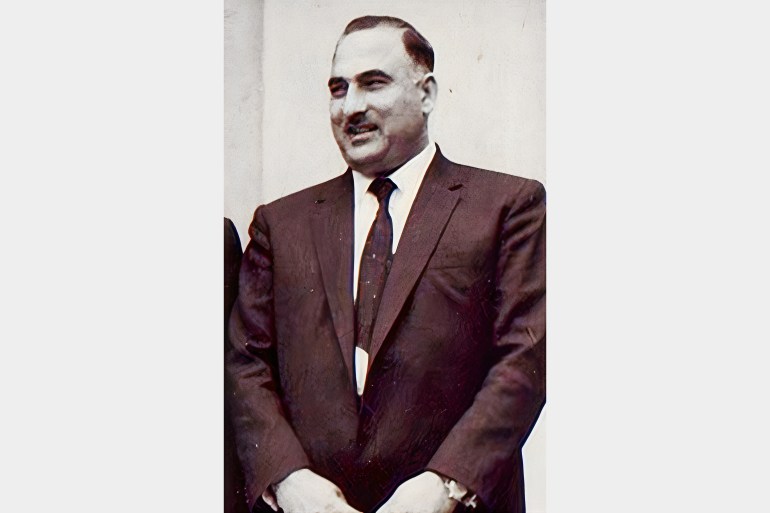The Iraqi writer, writer and author Qassem Muhammad Al-Rajab Al-Adhami lived a story of struggle during which he suffered a life of poverty and destitution, which led to the inability to buy school clothes or pay the price of the Eid dress for the tailor.
After a life devoted to books and a passion for them by searching for them, reading them, printing them, publishing them, and selling them, he died on the first of April 1974 at the age of 55, after a health illness that afflicted him.
Rajab was a lot of reading, strong memorizing the names of the flags, books and dates of deaths (communication sites)
hard beginnings
Rajab was born in 1918 AD in the city of Adhamiya in Baghdad, where he grew up and learned the Noble Qur’an, then completed his primary studies and did not continue his studies, and he has 4 children, according to the writer and historian Khaled Awsi Al-Adhami.
Speaking to Al-Jazeera Net, Al-Azami indicated that researchers and scholars used to refer to Professor Al-Rajab, who would tell them the sources and references that are relevant to their research and study.
Al-Azami quotes Rajab in his memoirs, talking about his beginnings, that his connection with the Saray market dates back to 1930, when he was forced to leave school with his brother, and he was in the sixth grade at the time when he was 12 years old, due to poverty and his inability to pay for school clothes.
He used to train to return to his home in Adhamiya on foot after leaving Al-Mamounia School and travel a long distance to save some money and buy part of the Book of Songs by Abu Faraj Al-Isfahani, and this book was credited with invigorating his reading spirit, according to Al-Azami.
Al-Rajab is one of the founders of the Imam Abu Hanifa Forum Association, and he donated to the association’s library many books and sources that he printed and published.
Rajab's journey in publishing books began in 1935 when he opened the Al-Muthanna Library in the middle of the book market in Baghdad (communication sites)
Al Muthanna Library
Al-Rajab’s journey in publishing books began in 1935 when he opened a small library in the middle of the book market in the Saray district of Baghdad, and its name was “Al-Ma’arri Library”, then changed its name to “Al-Muthanna Library” after one of his friends advised him to do so, according to his memoirs.
Al-Rajab succeeded in developing his library and achieving wide fame within a few years, and he communicated with large Arab publishing houses, and his experience expanded and his fame spread.
And the director of Al-Rafidain House for Printing and Publishing, Muhammad Hadi, notes that Al-Rajab initially worked with Hajj Noman Al-Azami in the modern library before he opened his own library, which he called "Al-Muthanna".
Hadi pointed out that Rajab was able to bring books to Iraq that are not found in other Arab countries (Al-Jazeera).
Speaking to Al Jazeera Net, Hadi saw that Rajab's breakthrough was when he imported a set of books and encyclopedias from Germany and the Netherlands and was able to sell them, so he did not start in a typical way as others do at the time when a few books arrived from Istanbul or Iran and were auctioned due to their rarity.
He confirms that he was able to introduce books that do not exist in the rest of the Arab countries, and he headed towards Lebanon and agreed with the publishing houses there.
He adds that Rajab expanded his work and issued the “Library” magazine, which was concerned with the latest publications, a magazine specialized in the profession of publishing, paperwork, and scribes.
Concerning the fate of the library today, Hadi says that it has become a stationery store, while the old library has completely disappeared because his children were busy with the profession of commercial printing and did not develop their father’s legacy in publishing.
The navigator saw that Rajab was one of the best and most famous owners of libraries in the middle of the last century in Iraq (Al-Jazeera)
intellectual role
The writer and researcher Ahmed Al-Mallah says that Al-Rajab is one of the best and most famous owners of libraries in the middle of the last century in Iraq, and one of the most important things he presented in his memoirs, which talked about the book’s reality in Iraq since the thirties of the last century, especially when he talks about Numan Al-Azami, the owner of the leading Arabic library in printing books Historical and heritage.
Al-Mallah adds to Al-Jazeera Net that Rajab accompanied the launch of printing in Iraq and the real Kutbi reality, especially in the thirties, forties, fifties and sixties of the last century.
He notes that the library magazine, in addition to being hosted by many important pens, was what distinguished it that it documented many details and events, in addition to heritage topics, especially the heritage and history of Baghdad.
While scholars place Rajab at the forefront of the modern intellectual awakening in Iraq, Al-Mallah praises his great role in the Iraqi thought movement in the middle of the last century.
The navigator states that one of the very painful things is that the library was exposed to a major fire in 1999 that destroyed all of the Muthanna library, which is full of books, first editions, manuscripts, and others.
his death
Regarding the circumstances of Rajab’s death on these days about half a century ago, Al-Adhami says that Rajab died of a heart attack in the Lebanese capital, Beirut, in 1974.
It appears that the body of the late was transferred to Baghdad and was buried in a large procession in the Great Imam Mosque. Historian Walid Al-Adhami witnessed the prayer over him. He was buried in the Al-Khayzaran cemetery in Adhamiya next to his friend, the famous calligrapher Hashem Muhammad Al-Baghdadi, near the shrine of Sheikh Abu Bakr Al-Shibli.

